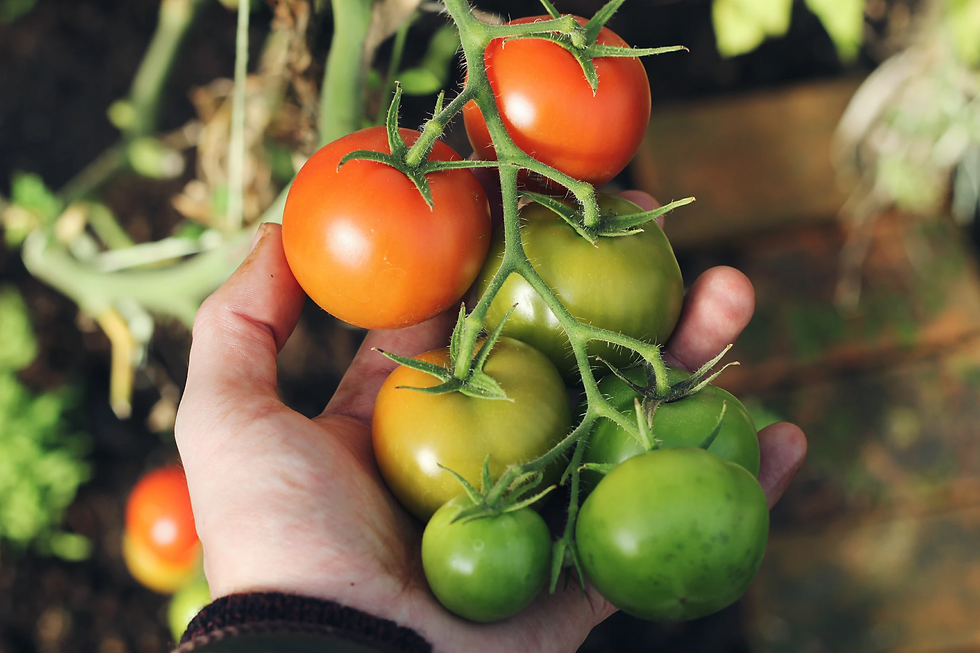Autumn Oak Lane: Vegetable gardening
- Justin Williams

- May 5, 2021
- 3 min read

In the springtime, you can sow seeds for the summer crop season. Pumpkin, watermelon, zucchini and all the other cucumber family plants have a long range of maturity. Short-season crops like radish and turnips can be sown alongside carrots in a garden bed.
These short-season crops can be underplanted under your vine crops to maximize space in the garden bed. You can use a trellis from big box stores or make your own with cattle panel and rebar staking. Heavy vines like watermelons and pumpkins need to have a heavy duty trellis which you can trellis over your garden to create a walking tunnel. If your watermelons get too heavy on the overhead trellis you can take old leggings or plastic bags and tie up the fruit set so it doesn’t snap off. This technique also maximizes vertical space and makes for a beautiful summertime experience.
You can plant pollinator-friendly flowers such as zinnias and dahlias in and around the veggies to attract bees to your garden oasis. Zinnias are flowers that are in the sunflower family and attract bees and hummingbirds to the garden to help pollinate the vegetables. These plants are directly sown into the ground in May through June and in April in some zones where they grow fast. They come in all different colors, are easy to cut for homegrown bouquets and are cheaper and easier to plant than the dahlia plant.
Tomato caging is a technique in which you use spiral cages and plant one tomato start for a cage. The levels of rings will support its growth and later on its fruit set. When starting tomatoes, you should tear the bottom leaves off and bury the stem deeper, up to the newest set of two leaves. This will create a powerful root system for the plant to pull nutrition from. In the wild, tomatoes crawl on the jungle and forest floor, so they root easily anywhere along their stems.
With tomatoes, their fruit will turn green-yellow and then red. When they are red is when you can pick them. Now, some variations have orange fruit, purple fruit and green fruit. With these you just need to look at the maturity statement and pick within a week of that.
Okra is a fast-growing midsummer crop and can easily fill in space with its large leaves and beautiful blossoms. When the blooms die the seed pods will be behind those blooms. You need to keep an eye on those and monitor the seeds on them in order to pick them at maximum ripeness. The usual time frame to pick them is two to three days after blooms die.
Corn is another good crop to have in your garden. It is easy to grow and is pollinated by the wind. You usually want to plant these in blocks of at least four so they can pollinate by the tassels blowing in the wind.
You can container garden or use a raised bed for any or all of these plants. When you start planting in the springtime you should amend the beds with compost. Plant these vegetables in a spot where they get full sun for about 6 to 8 hours a day. Harvesting should be done around the end of June to the end of July for the majority of these plants.
On a side note, you can also grow vining flowers on trellises to intermingle with the vegetables. These could be saucer cup vines, thunbergia, formerly known as black-eyed Susan vine, or morning glory. These will twine around the trellis and mix in with the vegetables to provide color in spaces where fruit and flower are not yet inhabited. These plantings will bring bees to the vegetables as well!
Enjoy and let me know if you have any questions or comments. Go get your hands dirty and play in the soil this summertime!








谷歌蜘蛛池搭建
谷歌快排
谷歌外链代发
谷歌留痕
谷歌蜘蛛池出租
谷歌快速排名
海外引流渠道
Telegram搜索引擎排名
巴西引流软件
谷歌霸屏技术
谷歌外推软件
四方支付系统
四方支付源码系统
四方支付系统源码
四方支付程序
四方支付平台源码
四方支付系统搭建
四方支付程序
四方支付平台搭建
四方支付系统源码
四方支付系统
四方支付系统
谷歌蜘蛛池搭建
go语言四方支付
四方支付系统源码2025
美国毕业证办理
四方支付
四方支付系统
国外毕业证书
办理美国毕业证书
美国留信认证
美国毕业证书
购买美国毕业证
美国留信认证
真实留信认证
留信认证
毕业证成绩单办理
购买美国留信认证
办理英国毕业证书
英国毕业证购买
英国毕业证书成绩单
订购英国学位证书
制作英国毕业证书
购买英国学位证书
英国文凭等级划分
定制英国毕业证书
补办英国毕业证
英国毕业证购买
BCH Miner BCH Miner
BCH Miner BCH Miner
BCH Miner BCH Miner
BCH Miner BCH Miner
BCH Miner BCH Miner
BCH Miner BCH Miner
BCH Miner BCH Miner
BCH Miner BCH Miner
BCH Miner BCH Miner
BCH Miner BCH Miner
BCH Miner BCH Miner
BCH Miner BCH Miner
BCH Miner BCH Miner
CESUR Mining CESUR Mining
stainless steel sheet stainless steel sheet
AV在线看 AV在线看;
自拍流出 自拍流出;
国产视频 国产视频;
日本无码 日本无码;
动漫肉番 动漫肉番;
吃瓜专区 吃瓜专区;
SM调教 SM调教;
ASMR ASMR;
国产探花 国产探花;
强奸乱伦 强奸乱伦;
AV在线看 AV在线看;
自拍流出 自拍流出;
国产视频 国产视频;
日本无码 日本无码;
动漫肉番 动漫肉番;
吃瓜专区 吃瓜专区;
SM调教 SM调教;
ASMR ASMR;
国产探花 国产探花;
强奸乱伦 强奸乱伦;
AV在线看 AV在线看;
自拍流出 自拍流出;
国产视频 国产视频;
日本无码 日本无码;
动漫肉番 动漫肉番;
吃瓜专区 吃瓜专区;
SM调教 SM调教;
ASMR ASMR;
国产探花 国产探花;
强奸乱伦 强奸乱伦;